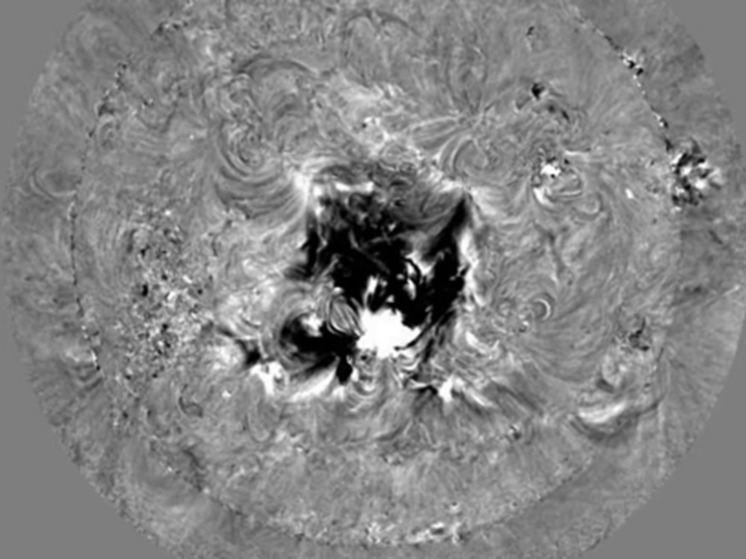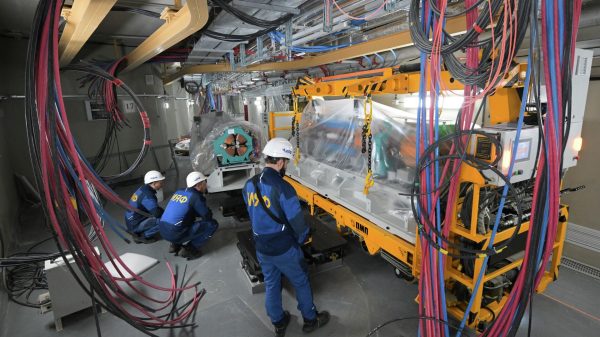Auroras may spread to southern regions
A “large” or even “very large” geomagnetic storm is expected to occur on the first day of winter. This was reported by scientists from the Institute of Terrestrial Magnetism, Ionosphere and Radio Wave Propagation named after. N.V. Pushkov Russian Academy of Sciences (IZMIRAN). It is possible that the predicted geomagnetic storm will be one of the most intense this year.
 Photo: SDO NASA, Image taken at the time of the solar flare, which occurred on November 28 at about 11 p.m. Moscow time. It was accompanied by the release of solar matter. The “black hole” in the image is what remained on the surface of the star after the ejection. This is dimming (darkening) or a temporary ravine on the surface, which very quickly filled again with solar plasma. Dimming is sometimes called a temporary coronal hole, but it is not related to classical coronal holes.
Photo: SDO NASA, Image taken at the time of the solar flare, which occurred on November 28 at about 11 p.m. Moscow time. It was accompanied by the release of solar matter. The “black hole” in the image is what remained on the surface of the star after the ejection. This is dimming (darkening) or a temporary ravine on the surface, which very quickly filled again with solar plasma. Dimming is sometimes called a temporary coronal hole, but it is not related to classical coronal holes.
The “parents” of the most serious disturbance in the magnetosphere of our planet were several, or rather 5 (!) fairly large events on the Sun.
It all started on November 27, when the Sun threw clots of plasma in our direction . Scientists call such events “fiber events.”
The so-called filaments are plasma formations that form along loops of the solar magnetic field. Due to its instability, when the magnetic balance is disturbed, the fiber is triggered like a stretched bowstring, throwing clots of plasma into space.
“On November 27, 4 large filament events occurred on the Sun at once,” explains the head of the IZMIRAN Space Weather Forecast Center, Candidate of Physical and Mathematical Sciences Artem Abunin. “They were relatively slow, but large and flew towards the Earth. We expected their arrival and increased geomagnetic activity (up to a moderate storm — Kp = 6) in the second half of November 30. But on November 28, around midnight Moscow time, the Sun presented another surprise — a flare was recorded that reached almost X-class — M9.8. It occurred in the active region numbered “13500” on the central meridian of our star. That is, just like previous ejections, the “13500” event was accompanied by a precise ejection towards the Earth. Since the filament events that occurred on November 27th have already collected most of the plasma during the flight to us, there is nothing stopping the ejection from November 28th from maintaining a high speed and not slowing down.
Thus, According to the head of the Center, after the geomagnetic storm, which scientists expect on Thursday, in the second half of November 30, a day later, on December 1, another one is likely to “hit”. She can “pull” already to Kp=8. Such storms are classified as “very large” — after them come only Kp=9 — “extreme” magnetic storms.
“Kr=8 will be realized if the field inside has a suitable orientation,” says Artem Abunin. – The fact is that the induction of the interplanetary magnetic field consists of three components: Bx, By, Bz. So, if the z-component, which is located vertical to our planet, is negative, geomagnetic disturbances will be registered. If it turns out to be positive, then the geomagnetic storm will be at a very low level, almost imperceptible to us.
In general, according to the scientist, it is now very difficult to make an accurate forecast:
– On approaching the Earth, five main events are now interacting at once; what is happening inside them is still unclear.
< /p>
– This happens when we have a slow ejection and a classic coronal hole, which can “shift”, turn the ejection away from the direction towards the Earth. But now this is not the case: we have five ejections at once and not a single coronal hole with a powerful outflow of solar plasma.
The American SDO observatory helps us observe bright events on the Sun. Videos appearing on the observatory's website in real time show the scale of the latest outbreak, which occurred on November 28, and they are impressive. Judging by the video, it seems that the Sun has catastrophically opened up in its very central part. According to astrophysicists, in the coming days, five portions of solar plasma, together with geomagnetic storms, will cause auroras of such strength that they can be observed not only in the northern, but also in the middle and even southern latitudes.




















































Свежие комментарии